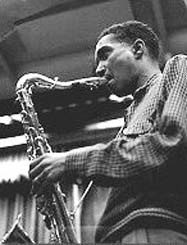Wardell Gray
| Wardell Gray | |
|---|---|
 |
|
| Background information | |
| Born |
February 13, 1921 Oklahoma City, Oklahoma, United States |
| Origin | Detroit, Michigan, United States |
| Died | May 25, 1955 (aged 34) Las Vegas, Nevada, United States |
| Genres | Jazz, swing, bebop |
| Occupation(s) | Tenor saxophonist |
| Instruments | Tenor saxophone, clarinet |
| Years active | 1940–1955 |
| Associated acts | Earl Hines, Benny Goodman, Count Basie, Dexter Gordon |
Wardell Gray (February 13, 1921 – May 25, 1955) was an American jazz tenor saxophonist who straddled the swing and bebop periods.
Wardell Gray was born in Oklahoma City, the youngest of four children. His early childhood years were spent in Oklahoma, before moving with his family to Detroit, Michigan in 1929.
In early 1935, Gray began attending Northeastern High School, and then transferred to Cass Technical High School, which is noted for having Donald Byrd, Lucky Thompson and Al McKibbon as alumni. He left in 1936, before graduating. Advised by his brother-in-law Junior Warren, as a teenager he started on the clarinet, but after hearing Lester Young on record with Count Basie, he was inspired to switch to the tenor saxophone.
Gray's first musical job was in Isaac Goodwin's small band, a part-time outfit that played local dances. When auditioning for another job, he was heard by Dorothy Patton, a young pianist who was forming a band in the Fraternal Club in Flint, Michigan, and she hired him. After a very happy year there, he moved to Jimmy Raschel's band (Raschel had recorded a few sides earlier in the 1930s but did not do so again) and then on to the Benny Carew band in Grand Rapids, Michigan. It was at around this time that he met Jeanne Goings; together they had a daughter, Anita, who was born in January 1941.
Just up the road from the Congo Club was the Three Sixes; Jeri knew Earl Hines, and when the Hines band came through Detroit in late 1943, she persuaded Earl to hire Wardell—on alto, since there was no tenor vacancy at the time.
This was a big break for the 21-year-old, as the Earl Hines Orchestra was not only nationally known, but it had nurtured the careers of some of the emerging bebop musicians, including Dizzy Gillespie and Charlie Parker. Although most of them had left by the time Gray joined, playing with the Hines band was still a lively and stimulating experience for the young tenor player. They toured the country, and it was when they were in California that Gray met Dorothy Duvall. They were immediately attracted to one another. Dorothy was married but, although the marriage was on the point of collapse, an unfortunate intervention by a "friend" led Gray to believe that this was not so, and he returned to Jeri; they were married in Chicago in September 1945.
...
Wikipedia
